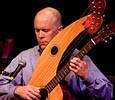 |
Volume 8, Issue 1, December, 2008
|
||||||||||||||
|
Slack-Key on the Harp Guitar by Pete Bradshaw |
|||||||||||||||
| Introduction Slack-key
guitar
is a beautiful style of music from Hawaii. It features rich major
harmonies and great resonance made possible by various open tunings. Well,
for resonance, what better instrument than a harp guitar? Not only
that, but with the sub-basses a whole new world of harmonics and even
minor slack key is possible, too. If
you are not familiar with slack key guitar music, try listening to
some examples before going too far with your own playing. Sample some
Keola Beamer, or get a copy of one of Dancing Cat Records’
compilations. Then explore the sounds and moods those players create.
Unlike a lot of other guitar music, slack key may not stretch your
ability to hit the right note – you will find many wonderful pieces
for which you can easily play the notes; however, getting the right
feel into the music will be an adventure. Neck:
C G d g b d1 The
last sub, in parentheses, is optional and included in case you have
six subs on your guitar. The rest of this article and all of the
examples and practice piece assume five subs. Note
that in Leonard’s C on a harp guitar with five subs, two of the strings are at the
same pitch (both tuned to C), and with six subs, another two are at
the same pitch (both tuned to G). That’s OK, and even
handy. More on that later. Getting Started Here
are a few things to explore in any new tuning. TAB for all of these
examples is compiled in the accompanying document
Slack Key Music on Harp
Guitar – Examples.
Getting the Sound Here are some ways to get a nice slack key sound. 1. Slow down. See if you can play as slowly as the great slack-key players. 2.
Let the guitar resonate.
Guitars sound great in slack key tunings. Harp guitars sound even
better. To bring out the sound as much as possible, slow down and let
the notes ring. 3.
Use vibrato freely.
At a nice slow tempo you should have plenty of time to work the
strings. 4.
Move the right hand a lot.
Try using just tone to bring color to the music. 5.
Dig deep with your right hand,
and angle your right hand fingers to produce big, round sounds. Try to
keep the string on your nail (or pick) as long as you can before
releasing it. Work at this in all right hand positions: near the neck,
over the sound hole, and near the bridge. 6.
Try using a very light touch
on certain notes on repeats. Sometimes play a note so quietly that you
just hint that it’s there. Make your audience fill in notes they
heard the first time through. Try to make the guitar sound like what
you’d hear if one were playing in the distance with a gentle breeze
blowing just enough so you can’t hear every note. 7.
Look for call and answer phrases.
A lot of slack key pieces have very nice repeated phrases that sound
great played in contrast to each other, e.g. loud/soft, round/sharp,
etc. 8.
Play it like you mean it.
A lot of slack key music is very personal. Choose a thought or an
image and evoke it with the music. 9.
Use silence.
It’s OK to let the guitar ring and then go silent. This is relaxing
music – take your time. Sample Piece References
About the Author Pete Bradshaw says he can’t remember a time when he didn’t want to make music. Classical piano lessons with Rachmaninoff protégé Boris Lang began at age 4. When his 4th grade teacher offered guitar lessons, piano studies were soon left behind. Pete’s next teacher set the groundwork for what he views as his path to the harp guitar with a Rachmaninoff prelude featuring a prominent descending bass line. Years later, Goran Sollscher’s arrangements of Bach cello suites for 11-string guitar provided the next step. It all came together when Pete heard instructor Stephen Bennett play harp guitar at one of Mark Hanson’s Accent On Music Guitar Seminars. Like Bennett, Pete plays a Merrill Dyer copy and a new Wingert harp guitar (Pete’s with 7 sub-basses). Maestro Bennett provided Pete’s harp guitar debut with a performance slot at the 5th annual Harp Guitar Gathering. His recording debut soon followed with a track on Harp Guitar Dreams. Pete’s music is inspired by classical and folk sources with a special focus on the Hawaiian slack-key guitar tradition. -FD |
|||||||||||||||
|
If you enjoyed this page, or found it useful for research, please consider supporting Harpguitars.net so that this information will be available for others like you and to future generations. Thanks!
|
|
All Site Contents Copyright © Gregg Miner, 2004,2005,2006. All Rights Reserved. Copyright and Fair Use of material and use of images: See Copyright and Fair Use policy. |